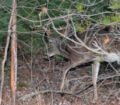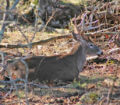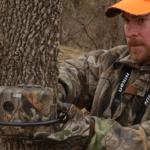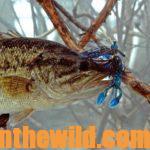Editor’s Note: If you put deer attractants along the edges of trails that deer use every day, they don’t have to find the attractants but will pass by them regularly. You’ll see more deer at your deer attractant sites next to trails, than if you just put an attractant out in the middle of the woods where there’s no deer sign at all.
 Food trails are the easiest and the most-obvious places for hunters to attempt to take deer. However, where you set-up on a food trail is vitally important to your success. An easy food trail to follow is one that leads to an agricultural field, because generally the deer will enter the field at a corner, a point or some other obvious passageway. Many deer hunters will take a stand 20- or 30-yards inside the wood line along the trail that goes to the field. However, the more often the trail is hunted, the more sensitive deer become to hunting pressure, and the more likely they are to stay well down the trail before dark.
Food trails are the easiest and the most-obvious places for hunters to attempt to take deer. However, where you set-up on a food trail is vitally important to your success. An easy food trail to follow is one that leads to an agricultural field, because generally the deer will enter the field at a corner, a point or some other obvious passageway. Many deer hunters will take a stand 20- or 30-yards inside the wood line along the trail that goes to the field. However, the more often the trail is hunted, the more sensitive deer become to hunting pressure, and the more likely they are to stay well down the trail before dark.
As my friend, Sam Spencer, a longtime deer hunter, comments, “I always set-up well away from a food plot to intercept a deer earlier, because many deer won’t enter a food plot until almost dark to be safe. Then the light’s too bad for me to shoot accurately.” Often the bigger, better-sized bucks will wait until just before dark 100- to 200-yards down the trails that lead to the green field. If you can find an alternative food source, like an acorn tree or some wild vegetation that deer are feeding on along that trail leading to the green field that they’ll enter at night, you’ve located a productive spot to take a buck. These deer remind me of partygoers who nibble on hors d’oeuvres before the banquet feast is served. By taking a stand near that snack food, you may have the opportunity to bag the big buck no one ever sees on the green field.
This situation is where deer attractants really can be a big help. If you’ll put your attractant site 100- or 200-yards away from the green field on the side of the trail the deer use to reach the green field or the agricultural crop, your chances of pulling older-age-class bucks into that area before dark are much greater. If the deer are feeding on acorns before they go to the green field, the scent of the deer attractant may pull the bucks further-up the trail more quickly than the acorns alone will. If there’s not a secondary food source for the deer to feed on before they go to the agricultural crop or the green field, then the attractant can act as a second food source to pull deer into a region and away from the green field during daylight hours, so you can get an effective shot. This tactic also works in reverse. Oftentimes when the deer leave the green field before first light, if you have an attractant site set-up, there’s a very-good chance that the deer will stop and hold at that place, giving you enough time to get-off a shot during legal shooting hours.
 One of the best areas to take deer is at a particular tree where deer are feeding. The most-productive food trees are isolated ones. For instance, if you find an apple tree in 500 acres of hardwoods where deer primarily are feeding or a white oak acorn tree, which is the deer’s preferred food in many parts of the country, the deer in that region probably are coming to that tree to eat. Because several trails from various directions may lead into that food tree, you may not be certain where to place your tree stand.
One of the best areas to take deer is at a particular tree where deer are feeding. The most-productive food trees are isolated ones. For instance, if you find an apple tree in 500 acres of hardwoods where deer primarily are feeding or a white oak acorn tree, which is the deer’s preferred food in many parts of the country, the deer in that region probably are coming to that tree to eat. Because several trails from various directions may lead into that food tree, you may not be certain where to place your tree stand.
However, you can funnel deer from one trail to another by using human odor as a barrier on the trails you don’t want the deer to travel down. Ronnie Groom of Panama City, Florida, a deer-hunting instructor at numerous outdoor schools across the South, suggests that you, “Move 150- to 200-yards away from the food tree. Walk across each one of the trails you don’t want the deer to use, being careful to leave plenty of human odor on these trails. When the deer come down the trail you’ve tried to X out, they’ll smell human odor, leave the trail they’re on and move to the trail you want them to walk down that doesn’t have human odor on it.”
 You also can put a deer attractant on the edge of one of the trails where you have the best stand location and the most-favorable wind. This way, instead of blocking the deer on the trails you don’t want them to come down, the attractant can pull the deer off the trails over to the attractant, before they go to the white oak acorn tree or the apple tree. Because of the drawing power of deer attractants, this tactic may be more productive in regions where the law permits the use of deer attractants, rather than using human odor. Often, if an older-age-class buck smells human odor in an area, especially across two to three of the trails he’s accustomed to using, he just may leave that section of land in search of another food source.
You also can put a deer attractant on the edge of one of the trails where you have the best stand location and the most-favorable wind. This way, instead of blocking the deer on the trails you don’t want them to come down, the attractant can pull the deer off the trails over to the attractant, before they go to the white oak acorn tree or the apple tree. Because of the drawing power of deer attractants, this tactic may be more productive in regions where the law permits the use of deer attractants, rather than using human odor. Often, if an older-age-class buck smells human odor in an area, especially across two to three of the trails he’s accustomed to using, he just may leave that section of land in search of another food source.
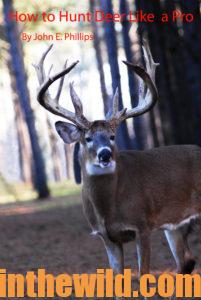
 To learn more about hunting deer, go to John E. Phillips’s book, “How to Hunt Deer Like a Pro” at https://www.amazon.com/How-Hunt-Deer-Like-Pro-ebook/dp/B007D3H08M. To receive your free book on “How to Make Venison Jerky,” go to https://www.emailmeform.com/builder/form/Ece3UZVcOo52cKPJcL
To learn more about hunting deer, go to John E. Phillips’s book, “How to Hunt Deer Like a Pro” at https://www.amazon.com/How-Hunt-Deer-Like-Pro-ebook/dp/B007D3H08M. To receive your free book on “How to Make Venison Jerky,” go to https://www.emailmeform.com/builder/form/Ece3UZVcOo52cKPJcL

